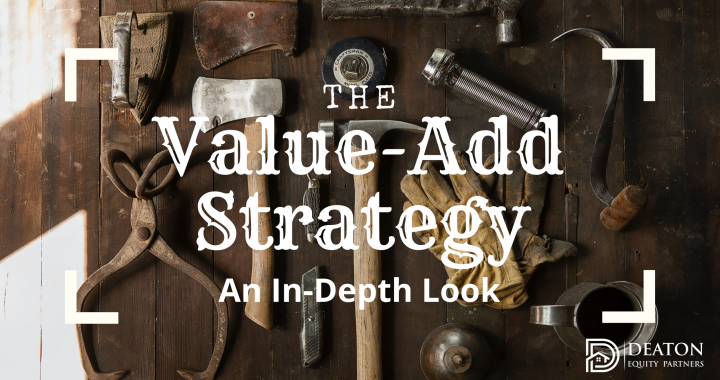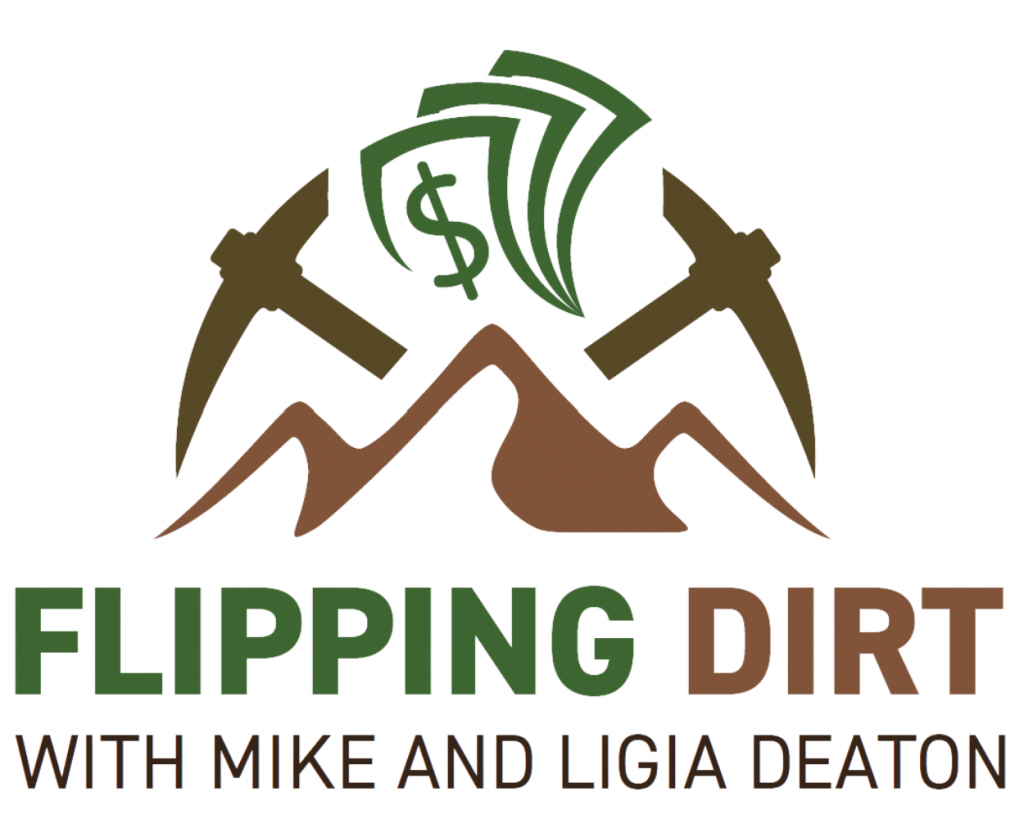The Value-Add Strategy
– An In-Depth Look –
Imagine driving down the street and spotting an old bookshelf sitting out on the curb. You pull over to check it out, and since it’s in pretty decent shape, you proceed to lug it home, clean it up and give it a fresh coat of paint.
A few years later, you sell the shelf to someone else who claims to have the perfect spot for it.
You took something that had been overlooked, committed some sweat equity, and breathed new life into it. This is the essence of a value-add investing strategy, and it’s a commonly used strategy in real estate investing.
The Basics of Value-Add Real Estate Investing
In the world of single-family homes, the process of buying a run-down property, remodeling it, and then selling it for a profit, is commonly referred to as “fix-and-flip”. Your ability to see a diamond in the rough along with your “sweat equity” is rewarded monetarily, and the new owner gets an updated, move-in ready home.
Value-add multifamily real estate deals follow a similar model, but on a big-time scale. Properties with hundreds of rental units get renovated over the course of a year or two instead of just one single-family home over several months.
A great value-add property may have peeling paint, outdated appliances, or overgrown landscaping, which all affect the curb appeal and the initial impression that a potential renter will have. Simple, cosmetic upgrades can attract more qualified renters and increase the income the property produces.
In value-add investments, improvements have two primary goals:
- To improve the individual units, the overall property and the community (positively impact residents)
- To increase the bottom line (and positively impact the investors)
Value-Add Examples
Common value-add renovations can include individual unit upgrades, such as:
- Fresh paint
- New cabinets
- New countertops
- New appliances
- New flooring
- Upgraded fixtures
In addition, adding value to exteriors and shared spaces often helps to increase the sense of community:
- Fresh paint on building exteriors
- New signage
- Landscaping
- Dog parks
- Gyms
- Pools
- Clubhouse
- Playgrounds
- Covered parking
- Shared spaces (BBQ pit, picnic area, etc.)
On top of all that, adding value can also take the form of increasing efficiencies:
- Green initiatives, like water savings, to decrease utility costs
- Shared cable and internet services
- Reducing overhead and expenses

Coordinating a Multifamily Value-Add Strategy
The basic fix-and-flip of single-family homes is pretty familiar to most people, but when it comes to hundreds of units at once, the renovation schedule and execution of a complex business plan aren’t as intuitive. Questions arise around how to renovate the property while people are living there and how many units can be improved at a time.
When renovating a multifamily property, the vacant units usually proceed first – the low-hanging fruit. In a 100-unit complex, a 5% vacancy rate means there are five empty units, which is where renovations will begin. Oftentimes when acquiring a target property, the vacancy rates are much, much higher, like 10-20%, and a large portion of any renovations can happen more quickly.
Once those initial units are complete, those units can be leased at a more appropriate rental rate. Additionally, as each existing tenant’s lease comes due for renewal, they are offered the opportunity to move into a freshly renovated unit. Usually, tenants are more than happy with the upgraded space and happy to pay a little extra.
Once tenants vacate their old units, renovations on those units take place, and the process continues to repeat until most or all of the units have been updated.
During this process, some tenants do move away, and it’s important for projects to account for a temporary increase in vacancy rates due to turnover and new leases. However, the property also begins to attract more new residents due to the improved appeal.
Why We Love Investing in Value-Add Properties
When done well, value-add strategies benefit all parties involved. Through renovations, we provide tenants a more aesthetically pleasing property, with updated appliances and a more attractive community space. By doing so, the property becomes more valuable (a concept known as ‘forced appreciation’), allowing higher rental rates and increased equity, which makes investors happy too.
The property-beautification process and the fact that renovated property is more attractive to tenants is probably straightforward. But let’s dive into why value-add investing is a great strategy for investors.
First, A Look at “Yield” Investment Strategies
To fully appreciate value-add investments, we must first understand their counterparts, yield plays. In a yield play, investors buy a stabilized asset and just aim to maintain steady operations for potential future profits.
Yield play investments are where a currently-cash-flowing property that is in decent shape is purchased and held in hopes to sell it for profit, without doing much, if anything, to improve it. Yield play investors hold property in anticipation of potential market increases, but there’s always the chance of experiencing a flat or down market instead.
In a yield play, everything is dependent upon the market. And as such, the returns on the investment are typically much lower.
Now…Back to Value-Adds
Value-add plays and yield plays are opposites. In a value-add investment, significant work (i.e., renovations and/or improved operations) takes place to improve the revenue and profit of a property, and thereby increase its value. The implementation of such improvements carries a significant level of risk.
However, value-add investment deals also come with a ton of potential upside, since the investors hold all the cards (back to forced appreciation). Through physical actions that improve the property’s appeal and financials, its value increases exponentially. Value-add investors don’t just hold the asset hoping for market increases. They force appreciation by improving a business asset.
Through those property improvements, additional income is increased, thus also increasing the value of the asset and generating more equity in the deal (of note, commercial properties are valued based on how much income they generate, not on similar, nearby properties, like single-family homes), which allows investors much more control over the investment than in a yield play.
Of course, the best of both worlds is ideal. This is where an asset gets improved as the market increases simultaneously. Investors have control over the value-add renovation portion and the market growth adds appreciation.
Now, before you get all excited about the potential of this hybrid investment, there are risks associated with any value-add deal.
Examples of Risk in Value-Add Investments
In multifamily value-add investments, common risks include:
- Not being able to achieve targeted rent growth
- More tenants moving out than expected
- Renovations running behind schedule
- Renovation costs exceeding initial estimates (which can be a big deal when you’re renovating hundreds of units)
Risk Mitigation
When evaluating deals as potential investments, it is critical to find sponsors who have capital preservation at the forefront of the plan and who have a number of risk mitigation strategies in place. These may include:
- Conservative underwriting (planning for rents less than maximum comps, padding the renovation budget, keeping a few improvement ideas in the back-pocket…)
- A proven business model (e.g. some units have already been upgraded and are already achieving the projected rent increases)
- An experienced team, particularly the project management team
- Multiple exit strategies
- The budget for renovations and capital expenditures is raised upfront, rather than through cash-flow
Value-add investments can be powerful vehicles of wealth, but, as mentioned, they also come with serious risks. This is why risk mitigation strategies are important – to protect investor capital at all costs.
Recap and Takeaways
No investment is risk-free. However, when something, despite its risks, provides great benefits to the community AND investors, it becomes quite attractive.
Properly leveraging investor capital in a value-add investment allows tremendous improvements in apartment communities, thereby creating cleaner, safer places to live and making resident families happier.
Because investors have control over how and when renovations are executed, rather than relying solely on market appreciation, they have more options when it comes to safeguarding capital and maximizing returns.
A real win-win-win! It’s a key driver in why we love creating Passive Income…for life!
Interested to learn more?
- EXPLORE more about the power of passive real estate investments in our section of other blogs and videos.
- SIGN UP for our newsletter for passive income-related content delivered right to your inbox
- JOIN our Passive Income Investors Group to gain access to multifamily investment opportunities and more behind the scenes content



